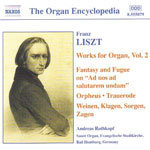
Liszt: Organ Works, Vol. 2 (Incl Orpheus, Symphonic Poem & Concertstuck in A major for organ in free style)
 $25.00
Out of Stock
$25.00
Out of Stock6+ weeks add to cart
FRANZ LISZT
Liszt: Organ Works, Vol. 2 (Incl Orpheus, Symphonic Poem & Concertstuck in A major for organ in free style)
Andreas Rothkopf (organ)
[ Naxos Organ Encyclopedia / CD ]
Release Date: Tuesday 11 May 2004
This item is currently out of stock. It may take 6 or more weeks to obtain from when you place your order as this is a specialist product.
"Liszt mavens and organ aficionados will certainly want this disc. Notes are informative and the sound is excellent. Another winner for Naxos."
- Robert Cummings, classical.net
Born at Raiding, in Hungary, in 1811, the son of Adam Liszt, a steward in the service of Haydn's former patrons, the Esterházy Princes, Franz Liszt had early encouragement from members of the Hungarian nobility, allowing him in 1822 to go to Vienna, for lessons with Czerny and a famous meeting with Beethoven. From there he moved to Paris, where Cherubini refused him admission to the Conservatoire, as a foreigner. Nevertheless he was able to impress audiences by his performance, now supported by the Erard family, piano manufacturers whose wares he was able to advertise in the concert tours on which he embarked. In 1827 Adam Liszt died, and Franz Liszt was now joined again by his mother in Paris, while using his time to teach, to read and benefit from the intellectual society with which he came into contact. His interest in virtuoso performance was renewed when he heard the great violinist Paganini, whose technical accomplishments he now set out to emulate.
The years that followed brought a series of compositions, including transcriptions of songs and operatic fantasies, part of the stock-in-trade of a virtuoso. Liszt's relationship with a married woman, the Comtesse Marie d'Agoult, led to his departure from Paris for years of travel abroad, first to Switzerland, then back to Paris, before leaving for Italy, Vienna and Hungary. By 1844 his relationship with his mistress, the mother of his three children, was at an end, but his concert activities continued until 1847, the year in which his association began with Carolyne zu Sayn-Wittgenstein, a Polish heiress, the estranged wife of a Russian prince. The following year he settled with her in Weimar, the city of Goethe, turning his attention now to the development of a newer form of orchestral music, the symphonic poem, and, as always, to the revision and publication of earlier compositions.
It was in 1861, at the age of fifty, that Liszt moved to Rome, following Princess Carolyne, who had settled there a year earlier. Divorce and annulment seemed to have opened the way to their marriage, but they now continued to live in separate apartments in the city. Liszt eventually took minor orders and developed a pattern of life that divided his time between Weimar, where he imparted advice to a younger generation, Rome, where he was able to pursue his religious interests, and Pest, where he returned now as a national hero. He died in 1886 in Bayreuth, where his daughter Cosima, widow of Richard Wagner, lived, concerned with the continued propagation of her husband's music.
While Liszt was one of the greatest pianists of his time, his skill on the organ was relatively limited by his lack of fluency in the use of the pedals. Nevertheless in Weimar he took a particular interest in the instrument. The city organist there since 1830 had been Johann Gottlob Töpfer, who had acquired a considerable level of expertise in the technical construction of the instrument, through the poor condition in which he had originally found the organ in the Herder Church. With his published work on the craft of organ-building, the first of which appeared in the early 1830s, he won a reputation as a leading authority on the subject. In the previous decade in Weimar he had collaborated with Johann Friedrich Schulze, an important organ-builder from Paulinzella, who was later responsible for the installation of an instrument in Bremen Cathedral, in changes to the defective Weimar organ under the influence of Töpfer's mathematical theories on organ construction. Liszt's association with Töpfer, who was twenty years his senior, brought a relationship with some of the latter's pupils, also students of Liszt, notably Alexander Wilhelm Gottschalg, who later became court organist in Weimar, his colleague Christian Bernhard Sulze, and Alexander Winterberger, who gave the inaugural recital on the Ladegast organ of Merseburg Cathedral in 1855, including Liszt's Fantasia and Fugue on the Chorale 'Ad nos, ad salutarem undam' in his programme. The organ that the Weissenfels builder Friedrich Ladegast had installed at Merseburg was then the largest in Germany, with 81 stops and four manuals. It was this instrument that inspired Liszt to write his Prelude and Fugue on the Name of BACH, a work given its first public performance at Merseburg by Winterberger. The organ itself, which followed the romantic tendency in organ-building influenced by Töpfer and put into practice in Germany by Schulze, appealed to Liszt through the varied and innovative possibilities of tone colour that it offered.
Liszt also explored, with Gottschalg, other organs in the neighbourhood of Weimar, while in Hungary he had access to two smaller instruments belonging to Count Széchényi at Nagycenk. For his own use in Pest he had a pianoforte-harmonium, an instrument with two manuals, one with the mechanism of a piano and the other a divided harmonium keyboard, allowing different registration and volume in the left-hand and right-hand half.
Tracks:
Fantasie und Fuge uber den Choral "Ad nos ad salutarem undam", S259/R380
Trauerode (Les morts: Oraison), S268/2/R390/2
Orpheus, Symphonic Poem, S98/R415
Concertstuck in A major for organ in free style, S172/3/R12/3
Weinen, Klagen, Sorgen, Zagen (Organ Prelude after J.S.Bach's Cantata), S179/R23
